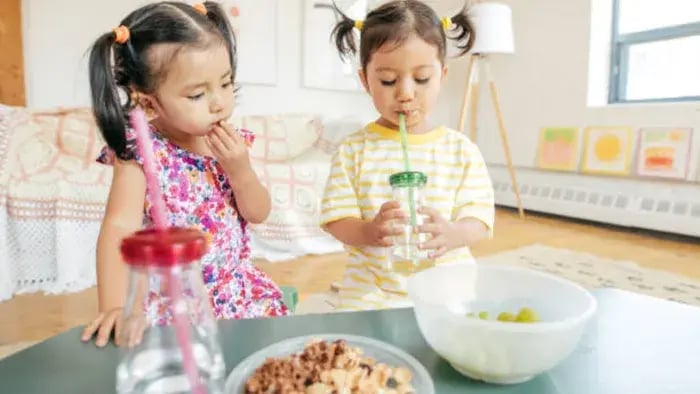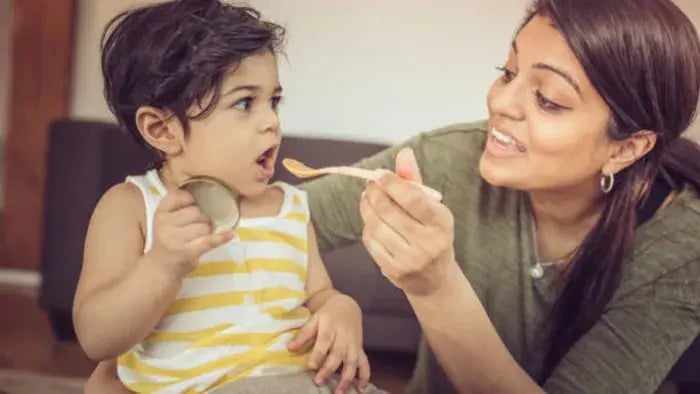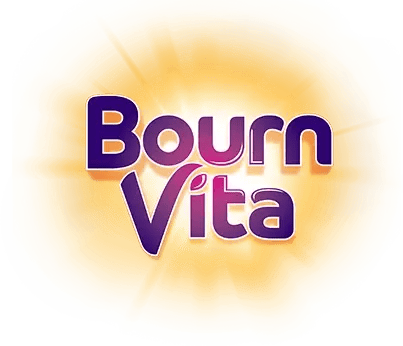- Moong Dal Khichdi
- Curd (Dahi)
- Mashed Sweet Potatoes
- Soft Paneer Cubes
- Seasonal Fruits (Banana, Papaya, Chikoo)
Introduction
A 2-year-old's diet plays a big role in their overall health, energy and growth. At this age, they are more active, curious and eager to explore the world around them, so their nutritional needs are higher than before. Their bodies are growing rapidly, bones are strengthening, muscles are forming, and the brain is making new connections every day. The right balance of food will support these growth milestones naturally.

Toddlers should have nutritious meals rich in protein, healthy fats, vitamins, minerals and complex carbohydrates. This is also the stage to introduce a wider variety of textures and flavors to help them develop healthy eating habits for life. Fresh fruits, vegetables, whole grains, dairy and protein sources all play a big role in giving them the nutrients they need for physical and mental development.
Every bite counts at this stage, so focus should be on foods that are nourishing and easy to digest. Choosing seasonal and fresh options will give better taste and nutrient content and make meals more enjoyable for your child. From small, frequent snacks to well-balanced main meals, every serving can help build stronger bones, boost immunity and support active play.
5 Delicious And Healthy Foods to Support Your Toddler’s Development

At 2 years old, your child is experiencing an exciting stage of growth and discovery. They are more active, playful, and eager to learn, which means their bodies need steady fuel to keep up with their pace. This is the time to give them meals rich in essential nutrients that support strong bones, healthy muscles, and an active brain. It’s also an ideal age to introduce variety, helping them enjoy different textures and flavors that shape lifelong eating habits.
Below are five wholesome foods that can help your 2-year-old grow stronger and healthier, while also enjoying their meals.
Moong Dal Khichdi
Moong dal khichdi is gentle on the stomach yet loaded with nutrition. According to the FSSAI, yellow moong dal provides protein for muscle growth, while rice offers easily digestible carbohydrates for energy. Adding a spoonful of ghee supplies healthy fats that aid brain development and improve nutrient absorption. You can also add soft-cooked seasonal vegetables like carrots, beans, and pumpkin for extra vitamins and fibre. A mildly seasoned, well-cooked khichdi ensures that it’s both nourishing and toddler-friendly.
Curd (Dahi)
As per the FSSAI, fresh curd is a great source of calcium for strong bones and teeth, along with probiotics that support digestion and gut health. Its creamy texture makes it easy for toddlers to enjoy, and you can pair it with soft fruits like bananas or mangoes for a naturally sweet snack. Homemade curd is best, as it’s free from added sugar and preservatives, and you can adjust the consistency to suit your child’s preference.
Mashed Sweet Potatoes
According to a study published in Food Sci Nutr. 2019, sweet potatoes are naturally sweet, rich in fibre, and packed with Vitamin A for healthy eyesight. They also contain potassium, which supports muscle function and heart health. Softly boiled and mashed sweet potatoes are easy to feed and can be mixed with a little ghee for added flavor and nutrition. You can even combine them with lentils or soft rice to make a wholesome meal that keeps your child full for longer.
Soft Paneer Cubes
A study published in J Food Sci Technol. 2011, shows that paneer is an excellent source of high-quality protein and calcium, two nutrients that are vital for your toddler’s growth. Soft, fresh paneer cubes are easy to chew and can be served plain, lightly sautéed, or mashed into parathas and upma. Since paneer is also rich in phosphorus, it works along with calcium to strengthen bones and teeth. Opt for fresh homemade paneer to ensure purity and softness.
Seasonal Fruits (Banana, Papaya, Chikoo)
According to CCRH, fruits like banana, papaya, and chikoo are naturally sweet, rich in vitamins, and gentle on the stomach. Bananas provide potassium and energy, papaya offers digestive enzymes and Vitamin C, while chikoo adds natural fibre for gut health. Cutting these into soft, bite-sized pieces makes them safe and easy for your toddler to eat.
Conclusion

Feeding your 2-year-old is not just about filling their stomach, it’s about building a strong foundation for lifelong health. The foods above offer a mix of protein, good fats, vitamins, and minerals that work together to support healthy growth and active play. By keeping meals fresh, varied, and balanced, you’re not only meeting their nutritional needs but also helping them develop a positive relationship with food that will serve them for years to come.
Her love for storytelling began with reading her grandfather’s speeches, where Tarishi saw the power of words in creating lasting memories. Combining her passions for food and writing, she has turned her life into a fulfilling path of sharing stories that celebrate flavours and how food brings communities together.
The views expressed are that of the expert alone.
The information provided in this content is for informational purposes only and should not be considered a substitute for professional medical advice, diagnosis, or treatment. Always seek the advice of your physician or another qualified healthcare provider before making any significant changes to your diet, exercise, or medication routines.
References
https://www.ccrhindia.nic.in/WriteReadData/LINKS/Compendium0c3fc504-fd77-45ab-9148-2407a787276c.pdf
https://pmc.ncbi.nlm.nih.gov/articles/PMC4008736/
https://pmc.ncbi.nlm.nih.gov/articles/PMC6593376/
https://www.fssai.gov.in/upload/knowledge_hub/19928164b641b8a487eHealthy%20food%20for%20Defence.pdf
















